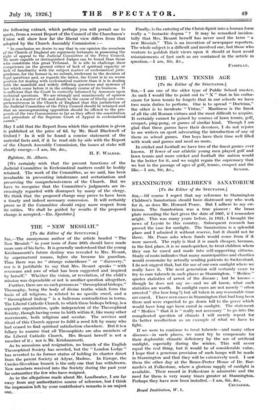STANNINGTON CHILDREN'S SANATORIUM
[To the Editor of the SPECTATOR.]
SIR,—Of course I regret that my reference to Stannington Children's Sanatorium should have distressed any who work for it, as does Mr. Howard Pease. But I adhere to my cri- ticism. The Sanatorium was a true pioneer : the brass plate recording the fact gives the date of 1907, if I remember aright. This was many years before, in 1921, I brought the news of Leysin to this country. Subsequent research has proved the case for sunlight. The Sanatorium is a splendid place and I admired it without reserve, but it should not be there. Mr. Pease asks where funds would come from if it were moved. The reply is that it is much cheaper, because, in the first place, it is so much quicker, to treat children where they can be cured and made into self-supporting citizens. Study of costs indicates that many municipalities and charities would economize by actually sending patients to Switzerland. I do not suggest that, but the use of our own sunlight where we really have it. The next generation will certainly cease to try to cure tubercle in such places as Stannington. " Medico " quotes statistics of arrest of the disease ; but he knows— though he does not say so—and we all know, what such statistics are worth. In sunlight cases arc not merely "often arrested" (for how long?) but all taken in any reasonable time are cured. I have seen cases in Stannington that had long been there and were expected to go down hill to the grave which would have long ago been cured in sunlight. The statement of" Medico " that it is "really not necessary" to go into the complicated question of climate I will merely repeat for its -better recollection as an example of what we have to fight.
If we were to continue to treat tubercle—and many other diseases—in such places, we must try to compensate for their deplorable climatic deficiency by the use of artificial sunlight, especially during the winter. This will never equal the real thing, but it would be of considerable value. I hope that a generous provision of such lamps will be made in Stannington and that they will be extensively used. I saw them the other day at the Bruce-Porter Home of Dr. Bar- nardo's at Folkestone, where a glorious supply of sunlight is available. Their record in Folkestone is admirable and the need for them is very many times greater at Stannington. Perhaps they have now been installed.—I am, Sir, ate.,










































 Previous page
Previous page